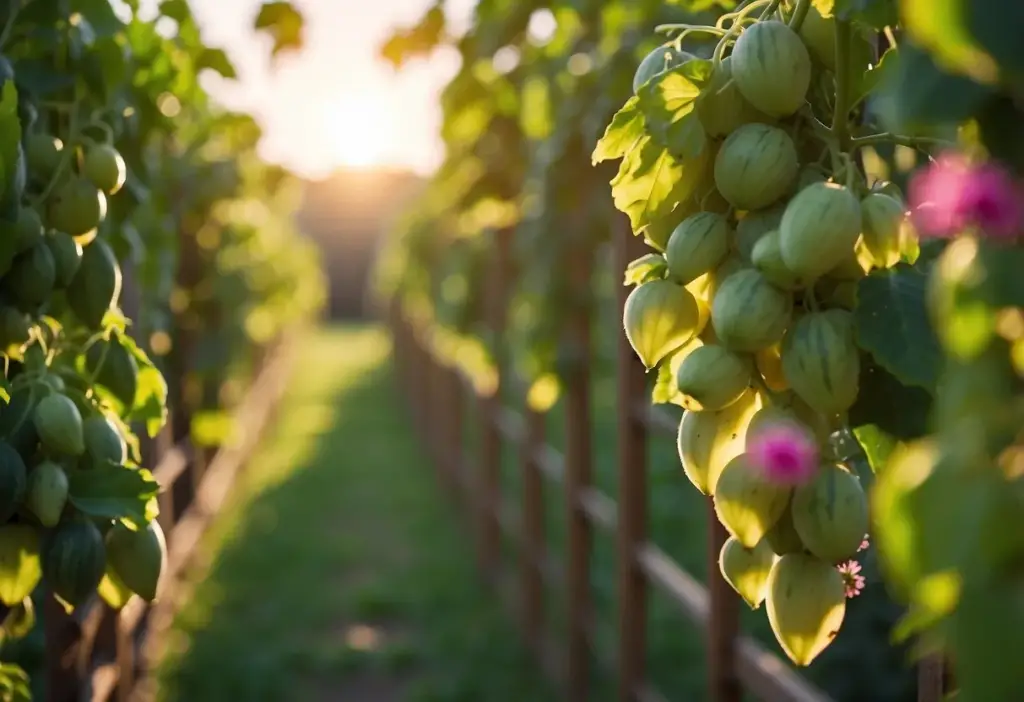
Do you intend to include watermelons in your garden this year? Growing watermelons can be an enjoyable and fulfilling endeavor, regardless of the size of your backyard or metropolitan area.
There are lots of original and useful suggestions to make your watermelon garden flourish. There are numerous strategies to guarantee a healthy crop, from picking the ideal location to offering the appropriate assistance and care. Anticipate relishing succulent, luscious watermelons straight from your very own yard!
Raised Garden Beds
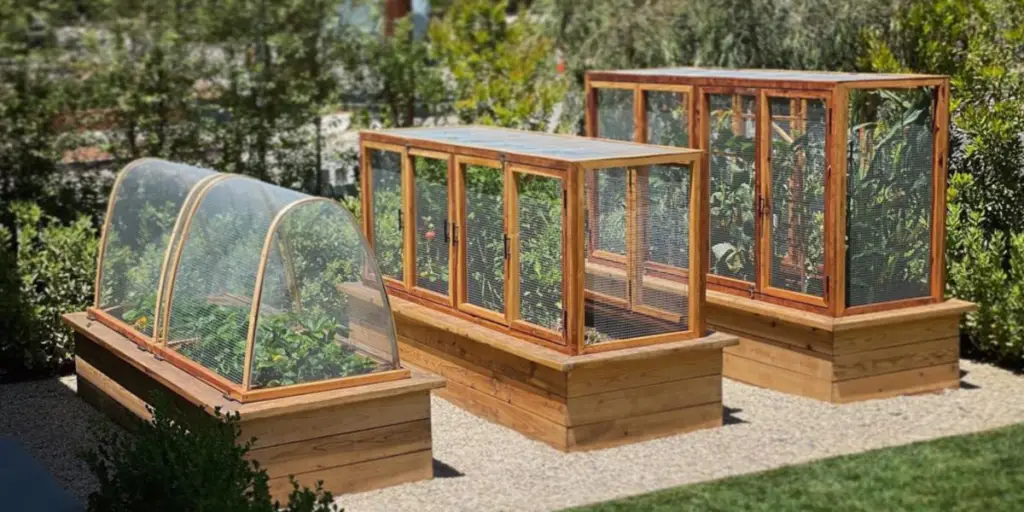
Raised garden beds are an excellent choice for cultivating watermelons. They provide better control over soil quality and promote good drainage, which is essential for these thirsty plants.
Position your raised bed in a spot that receives plenty of sunlight—watermelons need about 6-8 hours of direct sunlight daily to grow effectively.
Fill your bed with a well-draining, sandy loam soil, aiming for a pH level between 6.0 and 6.5. This type of soil provides the optimal environment for watermelon growth.
To make the most of your space, consider using a trellis. Supporting the vines vertically can prevent fruit from sitting on the ground, making harvesting easier and reducing the risk of pests.
Trellises for Vertical Growth

Growing watermelons vertically using trellises is a smart way to conserve garden space and keep fruits safe from ground pests and moisture-related issues.
A basic A-frame trellis, made from wood and wire, is an effective and easy option. Alternatively, a decorative wooden bridge trellis can add aesthetic appeal while supporting the vines.
If you already have an old fence or chain-link structure, it can double as a trellis. Just ensure it’s sturdy enough to bear the weight of the growing melons. This approach can keep your garden organized and visually appealing.
Mulch for Moisture Retention
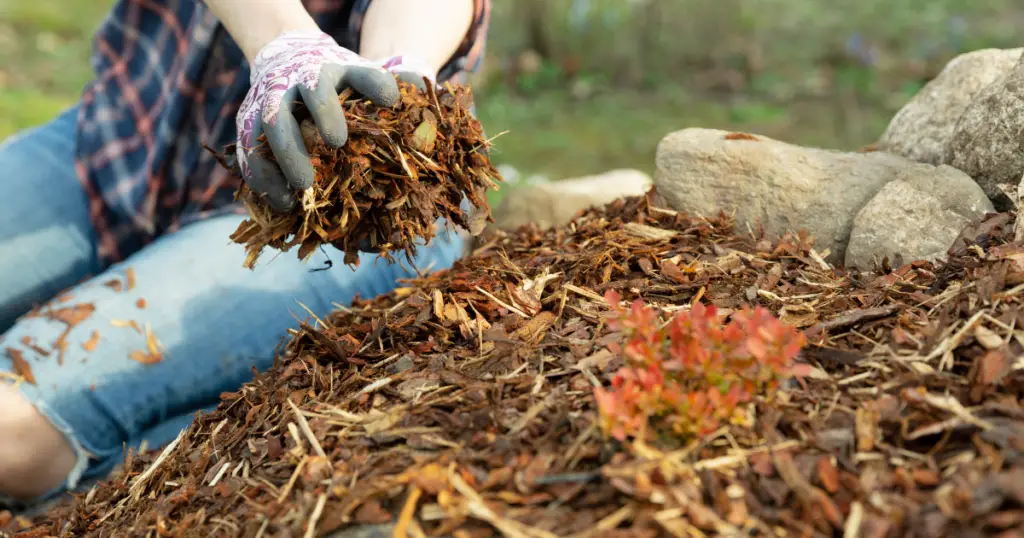
Mulching is a simple but effective technique to help your watermelon plants thrive. It helps retain soil moisture by reducing evaporation, which means less frequent watering.
Black plastic sheeting is a popular mulch choice for watermelon gardens. It not only conserves moisture but also warms the soil, providing an ideal growing environment. Secure the edges of the plastic with garden staples or rocks to keep it in place.
Companion Planting with Nasturtiums

Nasturtiums are a fantastic companion plant for watermelons. They attract beneficial insects, which aid in pollinating your watermelon flowers, improving fruit set.
Additionally, nasturtiums can act as a natural pest deterrent. They attract pests like aphids away from your watermelon plants, thus protecting your fruit. Plus, their bright, cheerful flowers can add a pop of color to your garden, enhancing its overall look.
Drip Irrigation System

Installing a drip irrigation system is a wise investment for your watermelon garden. This system delivers water directly to the plant roots, minimizing water waste and keeping the foliage dry, which helps prevent diseases.
Drip irrigation also reduces weed growth by limiting water exposure to non-target areas. You can easily set up your own drip system, which is often more cost-effective than buying pre-made kits, and it will keep your watermelons hydrated and healthy.
Compost for Soil Enrichment
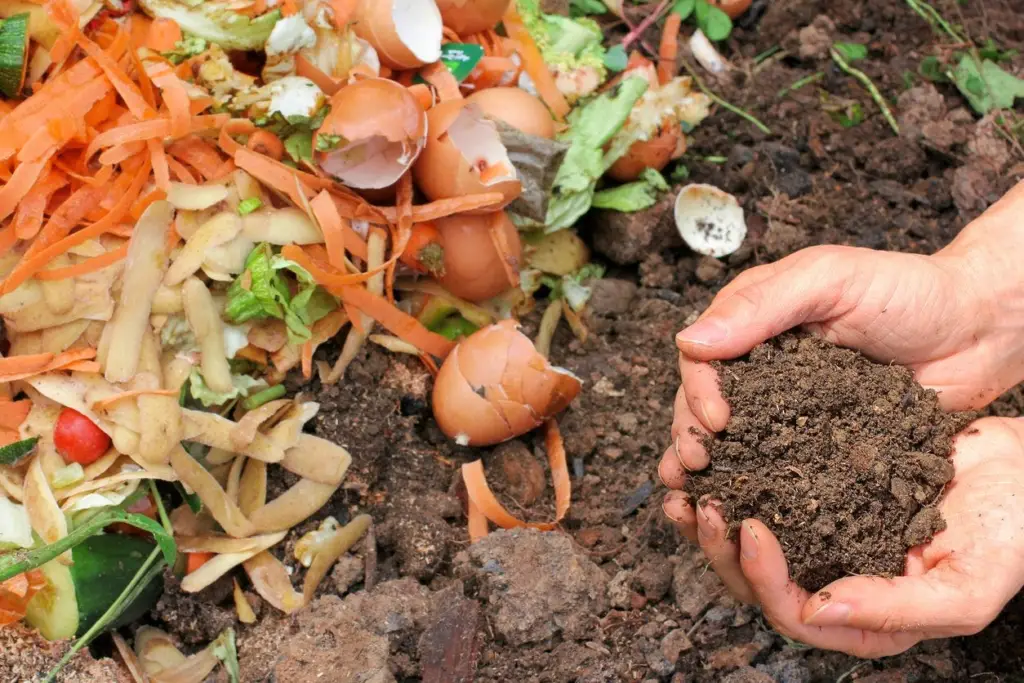
Incorporating watermelon rinds into your compost is an excellent way to enrich your garden soil. These rinds are rich in nitrogen, which is crucial for plant growth and a well-balanced compost mix.
Combine the rinds with carbon-rich materials like dry leaves or straw, maintaining a ratio of about three parts brown material to one part green. This mixture will break down into nutrient-rich compost that can be added to your garden beds, promoting healthier, more robust watermelon plants.
Bird Netting for Protection
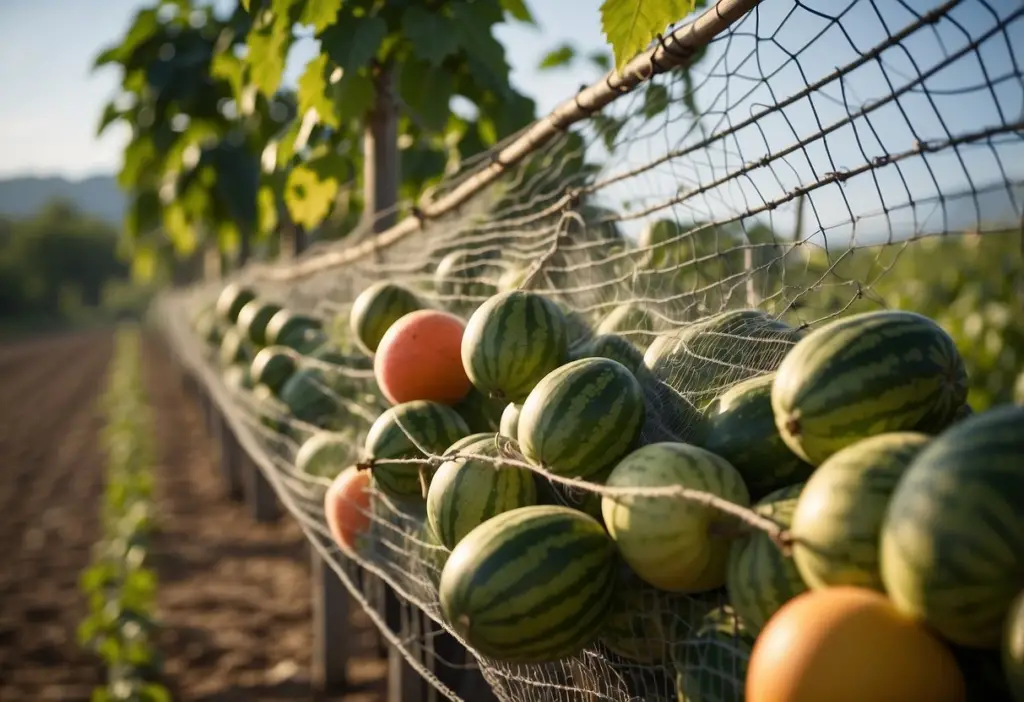
Using bird netting is an effective method to protect your watermelon crops from being eaten by birds.
Measure the area you want to protect and use garden hoops to create a framework around your plants. Drape the netting over the frame, securing it with ties or clips. This setup will keep birds at bay while still allowing sunlight and air to reach your plants.
Regularly inspect the netting for tears or gaps to ensure it continues to provide effective protection.
Organic Fertilizers

Organic fertilizers can significantly boost the health and productivity of your watermelon garden. They improve soil structure and supply essential nutrients for plant growth.
Compost is an excellent organic fertilizer, enhancing soil fertility and moisture retention. Other options include fish emulsion, which is high in nitrogen for leaf growth, and bone meal, which supplies phosphorus for strong root development. Blood meal is another good source of nitrogen, helping to maintain lush, green foliage.
Using these organic options can help ensure your watermelon plants are strong and productive.
Row Covers for Pest Control

Row covers are a practical solution for protecting your watermelon plants from pests. Made from lightweight fabric, they are easy to use and effective.
To use, simply drape the row cover over your plants and secure the edges with rocks or garden staples. This creates a barrier that prevents insects like aphids and beetles from reaching your plants.
Row covers also help to regulate temperature and shield plants from harsh weather, providing a safer growing environment for your watermelons.
Herb Spirals
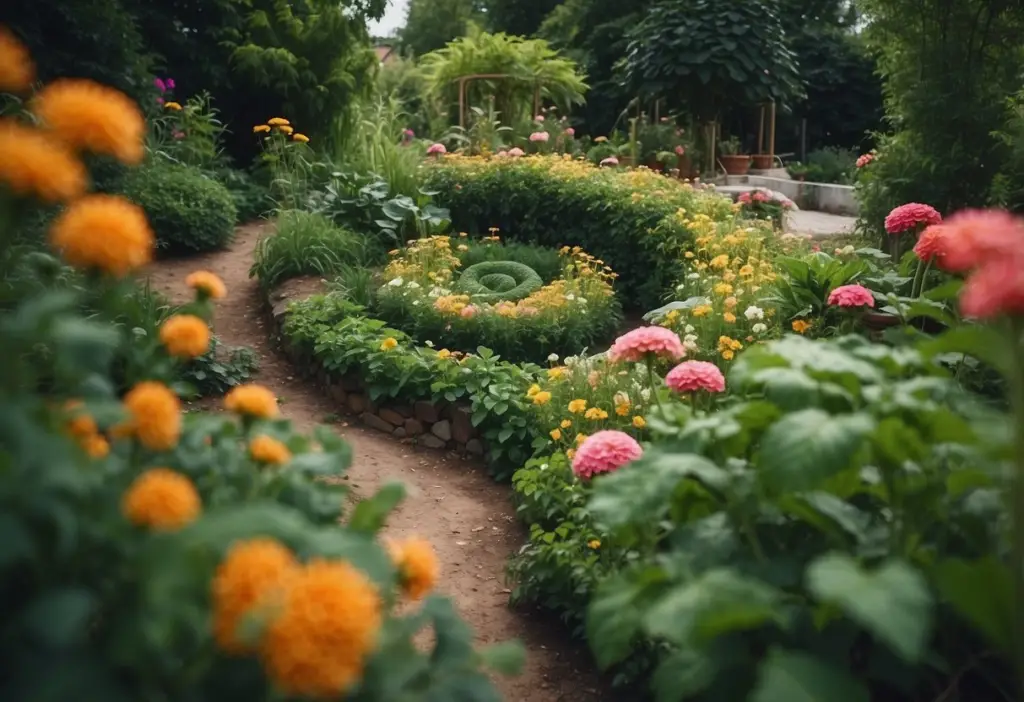
Incorporating an herb spiral into your watermelon garden can be both practical and attractive. Herb spirals use vertical space efficiently, allowing you to grow a variety of plants in a compact area.
Build the spiral by stacking stones in a spiral shape, starting with larger stones at the base and smaller ones as you move up. Fill the structure with soil and gravel for drainage.
Plant herbs that thrive in different conditions—place drought-tolerant herbs like rosemary at the top, where it’s drier, and moisture-loving herbs like parsley at the base. This design not only saves space but also adds visual interest to your garden.
Choosing the Right Location
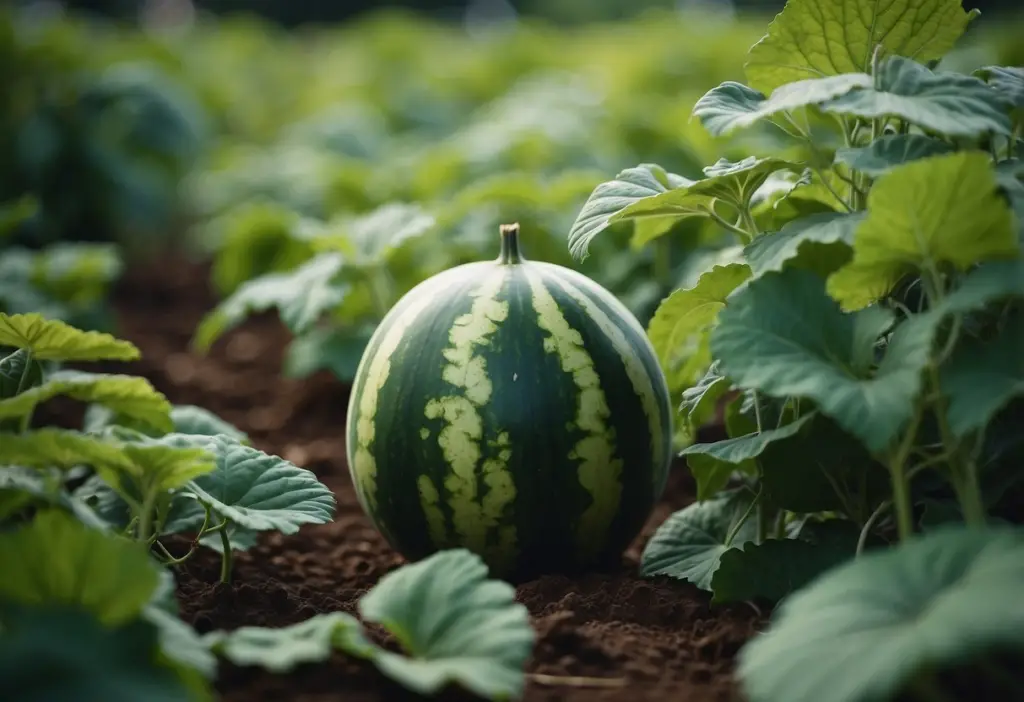
Finding the right location for your watermelon garden is crucial for a successful harvest. Focus on ensuring adequate sunlight and suitable soil conditions.
Sunlight Requirements
Watermelons thrive in full sun, requiring at least 8-10 hours of direct sunlight daily. Choose a garden spot that is open and sunny to help the plants produce sweet, flavorful fruits. Avoid shaded areas, as lack of sunlight can hinder growth and reduce fruit sweetness.
Important Tips:
- Avoid planting near tall structures that cast shadows.
- Space plants adequately to prevent them from shading each other.
- Opt for south-facing garden areas to maximize sunlight exposure.
Soil Conditions
Watermelons prefer well-drained, sandy loam soil rich in organic matter. The ideal pH range is between 6.0 and 6.8, which facilitates optimal nutrient absorption.
Important Tips:
- Enrich soil with compost or aged manure to boost fertility.
- Avoid areas prone to waterlogging to prevent root rot.
- Conduct regular soil tests to adjust pH and nutrient levels as needed.
By meeting these sunlight and soil requirements, you can create the ideal environment for growing healthy, delicious watermelons.
Planting and Growing Watermelons
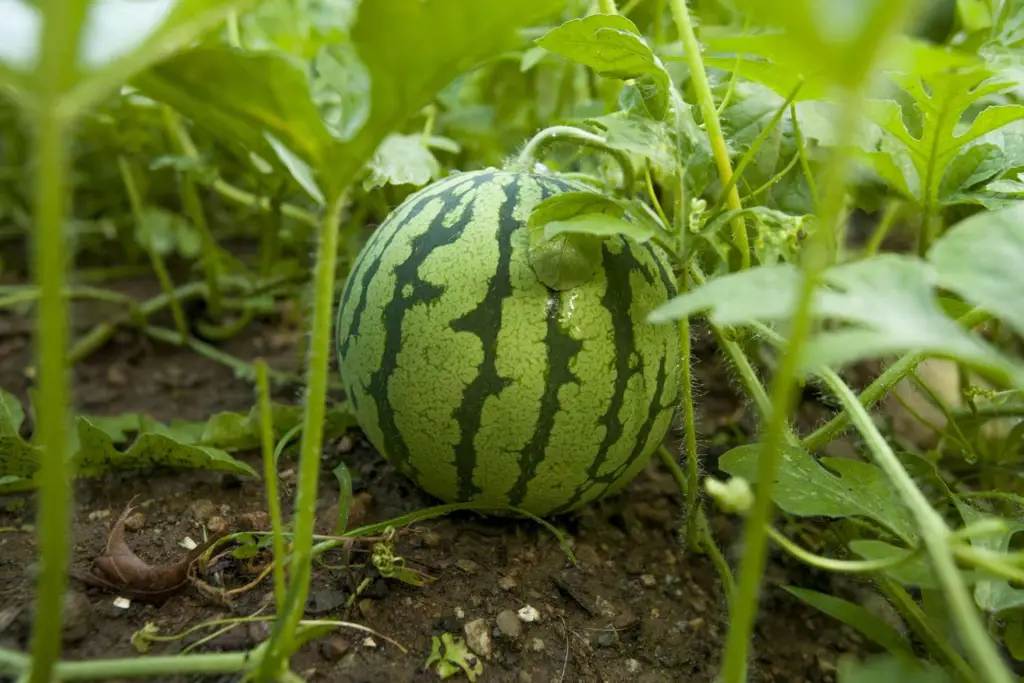
Successfully growing watermelons involves choosing the right variety, using proper planting techniques, and ensuring adequate water and nutrition.
Selecting Watermelon Varieties
Choose a variety that matches your climate and garden space. Compact varieties like ‘Sugar Baby’ and ‘Icebox’ are great for small gardens, while larger varieties like ‘Crimson Sweet’ and ‘Jubilee’ are suitable for more spacious areas.
Seedless varieties like ‘Tiffany’ are popular for their convenience, but they require a seeded variety nearby for pollination. Check the days to maturity on the seed packet to plan your growing season accordingly.
Planting Techniques
Prepare your garden soil by mixing in compost to enrich it. Plant seeds about half an inch deep in small hills or rows, spacing them 36 inches apart. For hills, plant 6-8 seeds per mound; for rows, space 2-3 seeds every 36 inches.
In cooler climates, start seeds indoors under grow lights or by a sunny window to give them a head start. This can help ensure faster germination and growth.
Watering and Nutrition
Watermelons need consistent moisture, especially during the initial stages of growth and fruit development. Water deeply once or twice a week, focusing on the base of the plants to avoid wetting the foliage, which can lead to disease.
Mulch around the plants to conserve moisture and keep the soil cool. Use a balanced fertilizer during the early growth stage, then switch to a phosphorus-rich fertilizer as the plants begin to flower. This supports strong fruit development and enhances the sweetness of the melons.
Managing Pests and Diseases

Keeping your watermelon plants healthy involves vigilant monitoring for pests and diseases. Knowing what to look for and taking preventive measures can help maintain a thriving garden.
Common Pests
Watermelon plants are susceptible to several pests, including aphids, cucumber beetles, and spider mites. Aphids can cause leaves to curl and yellow, while cucumber beetles can damage leaves and spread diseases like bacterial wilt. Spider mites create small yellow spots on leaves and can reduce plant vigor.
Early detection is crucial, especially for young seedlings. Thrips can also damage flowers and young fruits. Applying neem oil can help control these pests naturally.
Preventive Measures
Preventing pests and diseases is key to maintaining healthy watermelon plants. Plant in well-drained soil in sunny locations to reduce disease risk. Regularly inspect plants for signs of pests or disease, and act quickly if issues arise.
Encourage beneficial insects like ladybugs and lacewings to help control pest populations. Use clean tools and practice crop rotation to prevent disease spread. Watering plants in the morning allows the soil to dry out during the day, reducing the likelihood of fungal infections.
By staying proactive and using these management techniques, you can protect your watermelon plants and enjoy a bountiful harvest.
